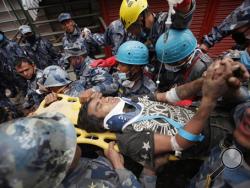Rescuers pull out survivor as Nepal capital remains on edge
Posted: April 30, 2015 - 4:43am
KATHMANDU, Nepal (AP) -- Thousands in Nepal's capital lined up to board free buses Thursday to return to rural hometowns amid fears over continued aftershocks. On an otherwise dreary day, this quake-hit nation got a rare bit of good news -- a teenager was rescued after being buried under rubble for five days.
Crowds cheered as the 18-year-old, identified by police as Pemba Tamang, was pulled out of the wreckage, dazed and dusty, and carried away on a stretcher. He had been pinned between collapsed floors of a seven-story building in Kathmandu.
Nepalese rescuers, supported by an American disaster response team, had been working for hours to free him. L.B. Basnet, the police officer who crawled into a gap to reach Tamang, said he was surprisingly responsive.
"He thanked me when I first approached him," said Basnet. "He told me his name, his address, and I gave him some water. I assured him we were near to him."
When Tamang was lifted out, his face was covered in dust, and medics had put an IV drop into his arm. A blue brace had been placed around his neck. He appeared stunned, and his eyes blinked in the sunlight as workers hurriedly carried him away.
The jubilant scene was welcome on a drizzly, chilly day in Kathmandu where many residents remained on edge over aftershocks that have rattled the city since Saturday's mammoth, magnitude 7.8 earthquake struck. The disaster has killed more than 5,500 people and destroyed thousands of houses and other buildings.
Since Monday, tens of thousands of people have left the capital on buses to check on relatives in rural areas or simply to get away from the damaged capital. The government has been providing free bus service to many destinations.
"I have to get home. It has already been so many days," said Shanti Kumari, with her 7-year-old daughter, who was desperate to check on relatives in her home village in eastern Nepal. "I want to get at least a night of peace."
Five days after the quake, tent cities in Kathmandu had thinned out, as overnight rainfall persuaded many people to return to their homes, even if they were damaged by the quake. The streets of the capital were slick with rain Thursday morning, the potholes were filled with water.
Still, life in the capital was slowly returning to the way it had been before the quake. Small snack shops were open. At a leather goods shop, a merchant brushed dust from a jacket on display. A man laid out carpets and rugs beneath an awning at a handicrafts store. Foreigners stood in line at a cellphone store.
"It's getting back to normal, but we're still feeling aftershocks. It still doesn't feel safe," said Prabhu Dutta, a 27-year-old banker from Kathmandu. He said he felt four aftershocks in the morning, including one that rattled the sliding glass doors of the bookshelf in his bedroom --"My morning wakeup notice," he said.
Dutta has been sleeping in his home, which has some cracks in the wall, for two nights, but the dozens of small aftershocks that he has felt since Saturday's huge quake make him uneasy. "I am worried about whether they will continue for a long time or whether it will calm down."
He said some people are returning to work, including at his bank, "but we can't concentrate. We roam around the office. We only have one topic of conversation: the earthquake."
Many people in Kathmandu are going to the country fearing that a big aftershock is coming, he said. "They are afraid; everyone is afraid because the earthquakes haven't stopped fully."
On Wednesday, helicopters finally brought food, temporary shelter and other aid to villages northwest of Kathmandu in the mountainous Gorkha District near the epicenter. Entire clusters of homes there were reduced to piles of stone and splintered wood. Women greeted the delivery with repeated cries of "We are hungry!"
While the death toll in the village of Gumda was low -- only five people were killed and 20 were injured among 1,300 residents -- most had lost their homes and desperately needed temporary shelter, along with the 40-kilogram (90-pound) sacks of rice that were delivered Wednesday.
Meanwhile, at least 210 foreign trekkers and residents stranded in the Langtang area north of Kathmandu had been rescued, government administrator Gautam Rimal said. The area, which borders Tibet, is popular with tourists.
Police said the official death toll in Nepal had reached 5,489. That figure did not include the 19 people killed at Mount Everest -- five foreign climbers and 14 Nepalese Sherpa guides -- when the quake caused an avalanche at base camp.
Dutta, the banker, said that while many of Kathmandu's cement and concrete buildings survived with only minor damage, many of the older buildings, ones made of tile or wood or bricks, have been leveled.
"Things have to return to normal, but it will take time," he said. "No one is ready to do the work needed to recover because of the closeness of the deaths. There is still shock."
___
Associated Press writers Binaj Gurubacharya in Kathmandu and Katy Daigle in Gumda, Nepal, contributed to this report.

